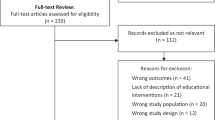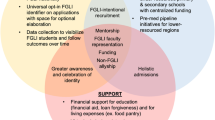Abstract
BACKGROUND
The University of California, Los Angeles (UCLA)/Charles R. Drew University Medical Education Program was developed to train physicians for practice in underserved areas. The UCLA/Drew Medical Education Program students receive basic science instruction at UCLA and complete their required clinical rotations in South Los Angeles, an impoverished urban community. We have previously shown that, in comparison to their UCLA counterparts, students in the Drew program had greater odds of maintaining their commitment to medically disadvantaged populations over the course of medical education.
OBJECTIVE
To examine the independent association of graduation from the UCLA/Drew program with subsequent choice of physician practice location. We hypothesized that participation in the UCLA/Drew program predicts future practice in medically disadvantaged areas, controlling for student demographics such as race/ethnicity and gender, indicators of socioeconomic status, and specialty choice.
DESIGN
Retrospective cohort study.
PARTICIPANTS
Graduates (1,071) of the UCLA School of Medicine and the UCLA/Drew Medical Education Program from 1985–1995, practicing in California in 2003 based on the address listed in the American Medical Association (AMA) Physician Masterfile.
MEASUREMENTS
Physician address was geocoded to a California Medical Service Study Area (MSSA). A medically disadvantaged community was defined as meeting any one of the following criteria: (a) federally designated HPSA or MUA; (b) rural area; (c) high minority area; or (d) high poverty area.
RESULTS
Fifty-three percent of UCLA/Drew graduates are located in medically disadvantaged areas, in contrast to 26.1% of UCLA graduates. In multivariate analyses, underrepresented minority race/ethnicity (OR: 1.57; 95% CI: 1.10–2.25) and participation in the Drew program (OR: 2.47; 95% CI: 1.59–3.83) were independent predictors of future practice in disadvantaged areas.
CONCLUSIONS
Physicians who graduated from the UCLA/Drew Medical Education Program have higher odds of practicing in underserved areas than those who completed the traditional UCLA curriculum, even after controlling for other factors such as race/ethnicity. The association between participation in the UCLA/Drew Medical Education Program and physician practice location suggests that medical education programs may reinforce student goals to practice in disadvantaged communities.

Similar content being viewed by others
References
COGME. Physician distribution and health care challenges in rural and Inner city areas, tenth report. Washington, D.C.: Council of Graduate Medical Education; February 1998.
Grumbach K, Coffman J, Liu R, Mertz E. Strategies for increasing physician supply in medically underserved communities in California. Berkeley: California Program on Access to Care, California Policy Research Center; 1999.
Rabinowitz HK, Diamond JJ, Veloski JJ, Gayle JA. The impact of multiple predictors on generalist physicians’ care of underserved populations. Am J Public Health. 2000;90(8):1225–1228.
Komaromy M, Grumbach K, Drake M, et al. The role of black and Hispanic physicians in providing health care for underserved populations. N Engl J Med. 1996;334(20):1305–1310.
Keith SN, Bell RM, Swanson AG, Williams AP. Effects of affirmative action in medical schools: a study of the class of 1975. N Engl J Med. 1985;313(24):1519–1525.
Cantor JC, Miles EL, Baker LC, Barker DC. Physician service to the underserved: implications for affirmative action in medical education. Inquiry. 1996;33(2):167–180.
Xu G, Veloski J, Hojat M, Politzer RM, Rabinowitz HK, Rattner SL. Factors influencing primary care physicians’ choice to practice in medically underserved areas. Acad Med. 1997;72(10 Suppl 1):S109–111.
Xu G, Veloski JJ, Barzansky B. Comparisons between older and usual-aged medical school graduates on the factors influencing their choices of primary care specialties. Acad Med. Nov 1997;72(11):1003–1007.
Rabinowitz HK. Critical factors for designing programs to increase the supply and retention of rural primary care physicians. JAMA. 2001;286(9):1041–1048.
Rabinowitz HK, Diamond JJ, Markham FW, Hazelwood CE. A program to increase the number of family physicians in rural and underserved areas: impact after 22 years. JAMA. 1999;281(3):255–260.
Keith SN, Bell RM, Williams AP. Affirmative action in medical education and its effect on Howard and Meharry: a study of the class of 1975. J Natl Med Assoc. February 1988;80(2):153–158.
Lloyd SM, Johnson DG. Practice patterns of black physicians: results of a survey of Howard University College of Medicine Alumni. J Natl Med Assoc 1982;74(2):129–141.
Johnson DG, Lloyd SM, Miller RL. A second survey of graduates of a traditionally black college of medicine. Acad Med. Feb 1989;64(2):87–94.
Ko M, Edelstein RA, Heslin KC, et al. Impact of the University of California, Los Angeles/Charles R. Drew University Medical Education Program on medical students’ intentions to practice in underserved areas. Acad Med. 2005;80(9):803–808.
Barnhart J, Shekelle P, Lewis C. The effect of a medical school’s admission and curriculum policies on increasing the number of physicians in primary care specialties. Acad Med. 1996;71(3):293–295.
Grumbach K, Hart G, Mertz E, Coffman JM, Palazzo L. Who is caring for the underserved? A comparison of primary care physicians and nonphysician clinicians in California and Washington. Ann Fam Med. 2003;1(2):97–104.
Goodman DC, Mick SS, Bott D, et al. Primary care service areas: a new tool for the evaluation of primary care services. Health Serv Res. 2003;38:287–309.
Nelson AR, Betancourt JR, Bloche MG. Unequal Treatment: Confronting Racial and Ethnic Disparities in Health Care. Washington DC: National Academy Press. 2002.
Tavernier LA, Connor PD, Gates D, Wan JY. Does exposure to medically underserved areas during training influence eventual choice of practice location? Med Educ. 2003;37:299–304.
Elam CL, Johnson MMS, Wiggs JS, Messmer JM, Brown PI, Hinkley R. Diversity in medical school: perceptions of first-year students at four southeastern US medical schools. Acad Med. 2001;76(1):60–65.
Trounson R. UC Sets Record on Freshman Enrollees for Fall. California: Los Angeles Times. June 2, 2006.
Acknowledgments
We would like to acknowledge the contributions of Lois Colburn, LuAnn Wilkerson, EdD, Deborah Danoff, MD, Carol Hodgson, PhD, Kehua Zhang, Shobita Rajagopalan, MD, Deyu Pan, MS, Magda A. Shaheen, MD, PhD, Elizabeth Mertz, MPA, and the staff of AMA data services for their guidance and assistance. We would also like to thank Dr. Keith Norris for institutional support. Renee Taylor provided administrative assistance. Data analysis and manuscript development was supported by the National Center for Research Resources (P20-RR11145 and G12-RR03026-15), the National Center on Minority Health and Health Disparities (1 P20MD00148-01), the Agency for Healthcare Research and Quality (1R24-HS014022-01A1) and (T 32-HS00046), and the Bureau of Health Professions, Health Resources and Services Administration (U79HP00004). The abstract from this study was presented at the Society of General Internal Medicine 29th Annual Meeting Poster Session, April 27, 2006.
Drs. Edelstein and Heslin are employees of the Charles R. Drew University of Medicine and Science and are faculty members of the David Geffen School of Medicine at UCLA.
Conflicts of interest
None disclosed.
Author information
Authors and Affiliations
Corresponding author
Rights and permissions
About this article
Cite this article
Ko, M., Heslin, K.C., Edelstein, R.A. et al. The Role of Medical Education in Reducing Health Care Disparities: The First Ten Years of the UCLA/Drew Medical Education Program. J GEN INTERN MED 22, 625–631 (2007). https://doi.org/10.1007/s11606-007-0154-z
Received:
Revised:
Accepted:
Published:
Issue Date:
DOI: https://doi.org/10.1007/s11606-007-0154-z




